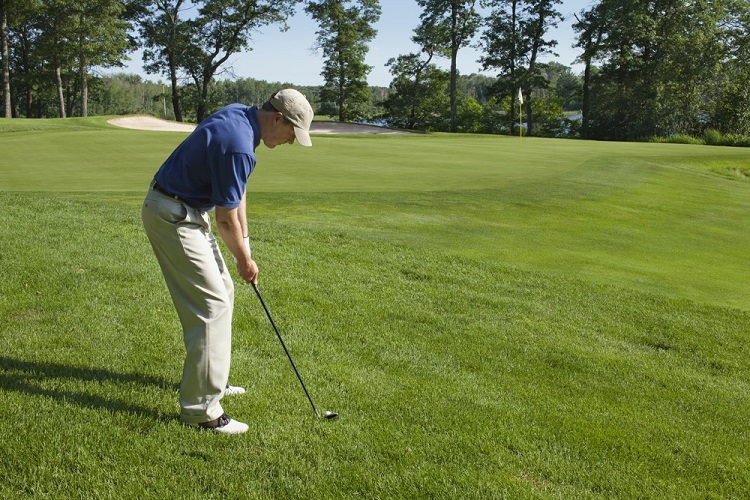Learning how to chip in golf effectively remains one of the most important methods to lowering scores.
By developing a smooth chipping stroke that works regardless of the situation, whether sitting in thicker rough or just off the green, you can save more pars and potentially make a birdie here and there.
In this guide, I’ll work you through the steps to help you build the correct setup to produce a chipping motion that will enable you to reach your golfing goals.
How to Chip in Golf
Open the Club Face
One of the best tips for chipping well is by opening the face slightly at address. The open face helps you utilize the club’s bounce by giving you more room to use a descending blow with your pitching wedge to prevent hitting the ball thin.
Ball Position Dictates Results
All three positions deliver a different type of result:
- Front position produces more spin
- Center position creates bounce and spin to check up
- Rear ball position gives you low spin chip shots that release to the hole
Feet Close Together
Chipping the ball demands a quiet upper body with a tight, compact swing. The same holds true for your feet. Rather than keeping them apart, as you would when you swing a 5-iron, instead keep your feet close together like you would when putting.
If you play the ball center, your weight will move to the lead foot, and your right shoulder will up and level with the left shoulder rather than dip down to help the shot into the air.
Shoulders Stay Level
The left shoulder and right shoulder stay level during the chipping motion. Moving either shoulder too high or too low can decrease the odds of making solid contact.
Working to keep the swing compact with a limited backswing and follow through assures you are moving cleanly through impact with little chance of hitting the shot off-center on the face.
Hands Ahead of Ball
Most golfers make mistakes by flipping the wrists through the golf ball and getting the head in front of the hands. At impact, you want your hands slightly ahead of the impact point so you can better control the flight and distance of the shot.
At address, you can move your hands toward your lead hip to produce the lean you want to experience at impact.
Hinge the Wrists
If you are using a wedge and want to lift the chip shot, you’ll need to hinge your wrists in the backswing. If you are a right-handed golfer, the right wrist will hinge to bring the club back to your desired height.
Remember, the lead wrist should stay relatively flat during the takeaway so you can descend the face into the proper chip shot.
You’ll still need to finish smoothly with your hands in front of the ball and your right shoulder, helping the club through the impact zone.
Hit the Ball First
You want to make contact with the ball first by getting that leading edge between the outer layer and the ground.
By making clean contact with your hands slightly forward on the target side of your stance, the face can produce the spin necessary to either stop cold on the putting surface or check up and release to the club.
Finish Low When You Want the Ball Low
On the follow through, your club head should mimic the ball’s flight. For example, if you want the ball to stay low and release to the cup, keep your hands forward on your left side and low to the target.
If you want the ball to raise into the air, then your hands should allow the club head to finish at waist high. If you want to hit the shot high, you’ll need to rotate your body through impact with your sternum facing the target.

PRO TIP
Accelerate Through the Ball Drill
Too many golfers slow the club head down as it moves toward the impact point rather than accelerating through impact when chipping. Usually, this occurs when the upper body takes the club way too far back, forcing the golfer to slow the club head down on a shorter chip shot.
Next time you are at the driving range, take a bucket of golf balls, a lower-lofted club, such as a 7-iron, and reduce the size of your backswing with an emphasis on moving the club head through the ball with acceleration.

PRO TIP
Bump and Run Drill
The bump and run drill is one of the best drills for understanding how different clubs produce distance control. Take a 7-iron, gap wedge, and lob wedge to the practice green and chip the ball with each club.
Work on your distance control with these chipping clubs by making proper contact with the golf ball and seeing how the loft of each wedge creates varying spin rates.
The basic idea is how the clubs produce the same distance but in different ways. Even with shorter chips, the clubs give you options for hitting short game shots.
Frequently Asked Questions
What is the best way to chip in golf?
The best way to chip in golf involves using a consistent setup and technique. Position the ball in the center of your stance with a narrow stance and weight slightly on your front foot.
Use a lofted club, such as a pitching wedge or sand wedge. Keep your hands ahead of the ball at address and during the putting stroke. Focus on making a smooth, controlled swing with minimal wrist movement.
Maintain a stable lower body, letting your upper body and arms control the shot. Aim to make contact with the ball first, then the ground. This ensures a clean strike, resulting in better control over distance and direction.
Practice different lies and distances to improve consistency and adaptability. By refining these aspects, you can develop a reliable chipping technique that enhances your short game and lowers your scores.
How do you chip a golf ball for beginners?
Beginners should focus on a simple, repeatable chipping technique. They should start with a narrow stance and place the ball in the center.
Shift your weight slightly onto your front foot and keep it there throughout the swing. Use a lofted club like a pitching wedge. Keep your hands ahead of the ball at address. Maintain a light grip pressure and focus on a smooth, pendulum-like stroke.
Avoid excessive wrist movement; let your shoulders and arms control the swing.
Aim to strike the ball first, followed by a shallow divot. Practice this basic technique from different lies and distances to build confidence and consistency.
By mastering these fundamentals, beginners can develop a solid chipping foundation, leading to improved performance around the greens.
How to be a good chipper in golf?
To be a good chipper, consistency and practice are essential. Develop a reliable setup: narrow stance, ball centered, weight slightly on the front foot.
Use a lofted club suitable for the shot. Keep your hands ahead of the ball and maintain a light grip. Focus on a smooth, controlled swing with minimal wrist action, using your shoulders and arms to move the club.
Practice different lies and distances to adapt to various conditions. Pay attention to the ball position and adjust accordingly for different shots. Develop a pre-shot routine to ensure consistency.
Analyze your results and make adjustments as needed. Regular practice, attention to technique, and consistency will help you become a good chipper.
How do you grip when chipping?
When chipping, grip the club lightly to ensure control and sensitivity. Position your hands slightly ahead of the ball at address, promoting a descending strike.
Use a neutral grip with both hands, ensuring they work together. The left hand (for right-handed golfers) should lead the swing, guiding the club through impact.
Avoid excessive wrist movement; keep your wrists firm to maintain control. Your grip pressure should be light, around a 4 out of 10, to allow for a smooth, controlled stroke.
This grip technique helps achieve a consistent, repeatable chipping motion, improving accuracy and distance control. Practice regularly to develop a comfortable, effective grip that enhances your chipping performance.
How do you set up chipping in golf?
To be a great chipper, you should set your body up with your shoulders level, your feet slightly open, and the ball in one of three positions; with the ball center of stance, ball forward and directly under the front armpit, or ball position in the back of the stance, under the rear armpit.
As you address the ball, your hands should be forward with a slight amount of shaft lean. With your hands slightly ahead of the ball with weight on the inner part of the left side foot.
If you play a low-lofted iron, your takeaway will be low and along the ground. With a lob wedge, the takeaway utilizes hinged wrists to produce the steep angle needed to get the club’s leading edge under the golf ball to create spin.
What should you chip with in golf?
Experienced golfers take their chip shots with various clubs, depending on the situation on the golf course. With deeper rough, a low handicapper could use a sand wedge with the hinge and hold method to create lift and generate spin.
For high handicappers, chipping with a lower lofted iron, such as a 7-iron, allows the golfer to use a putting stroke with a forward shaft lean when chipping.
Minimizing the movement typically associated with chipping allows you to find more consistent contact and maintain the target line more efficiently.
Final Thoughts
Every golfer has a unique chipping setup, but the process and results all strive for the same results.
If you are having a tough time finding short game consistency with your chipping technique, remember to be patient and put in the work building your basic technique and fundamental approach.
Putting the drills in this article to use on the driving range can shorten the learning curve and help you when you work on making solid contact more consistently.
